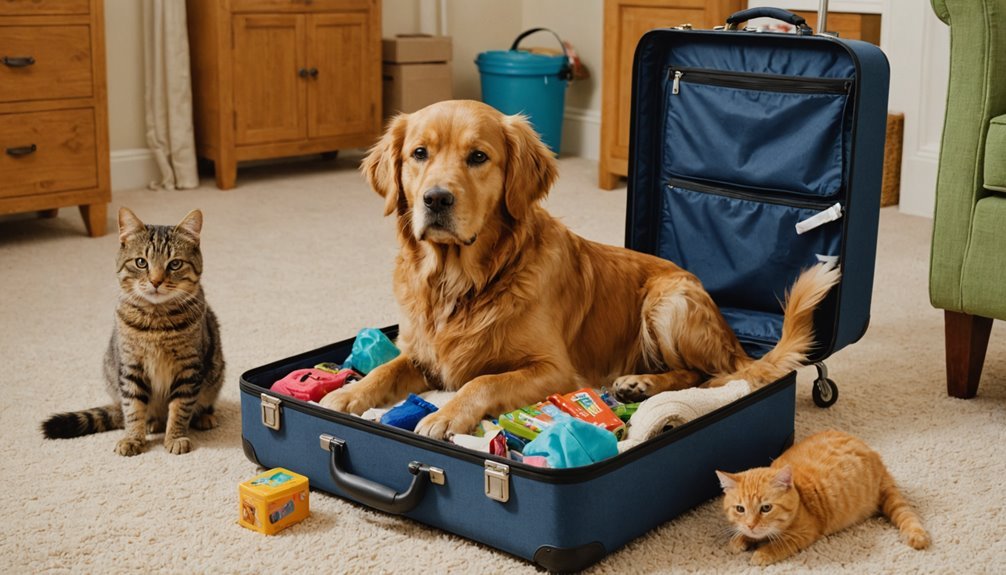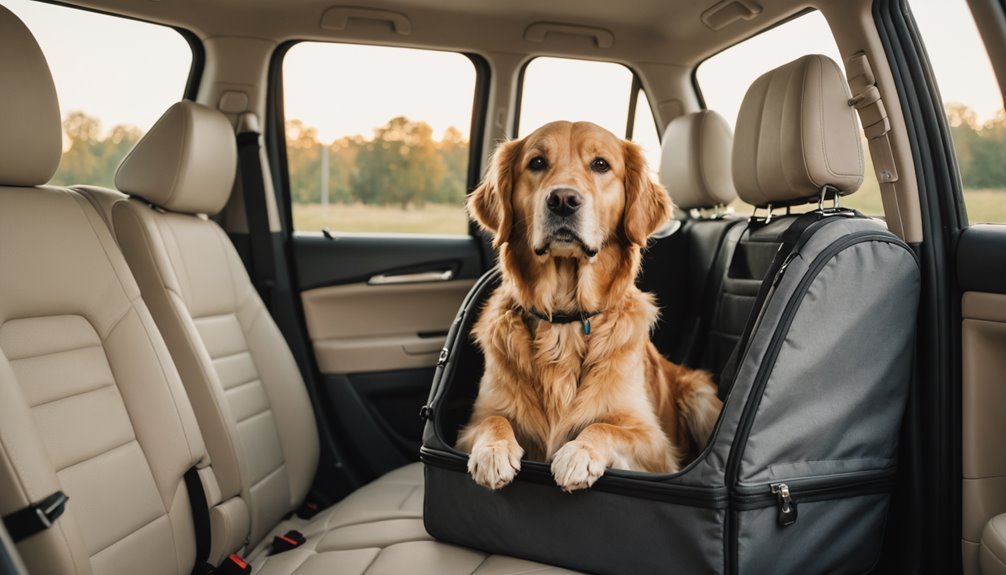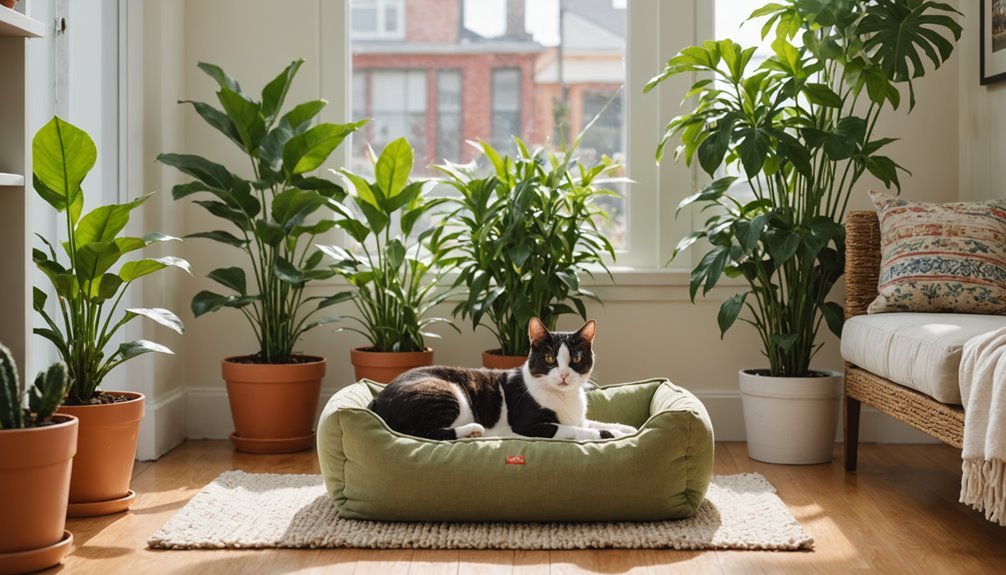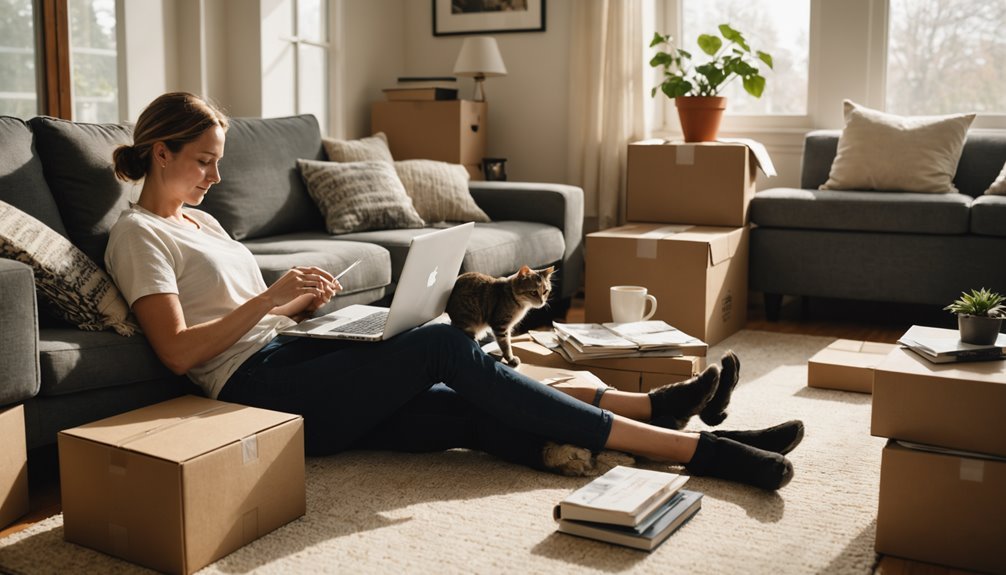When you're planning a move with your furry companion, there's more to contemplate than just packing their toys and bowls. You've got to guarantee their comfort and safety every step of the way, from the old residence to the new. But where do you start? One critical step is acclimating your pet to their travel carrier well before moving day, reducing their stress considerably. However, that's just the beginning. If you're curious about what other measures can be taken to ease your pet's shift, reflect on the importance of maintaining their routine amidst the upheaval.
Key Takeaways
- Schedule a veterinary checkup and update your pet's microchip and ID tags before moving.
- Gradually introduce your pet to packing materials to reduce anxiety.
- On moving day, keep pets in a quiet, safe area with familiar items.
- Establish a consistent routine quickly in the new home to help pets adjust.
- Observe your pet's behavior for signs of stress and consult a vet if needed.
Understanding Pet Relocation Needs
Understanding the needs of your pet during relocation is essential to minimize their anxiety and stress. When you're planning a move, recognizing your pet's relocation needs early can make a huge difference. It's not just about moving your stuff; it's about safely and comfortably relocating your furry family member too.
Firstly, preparing your pet means acclimating them to their travel carriers and car rides. Start this process well in advance of the move to reduce their stress when the big day arrives.
Consider hiring a pet transport company that prioritizes the safety and comfort of your pet. These professionals know how to handle animals with care during changes, ensuring they're calm and secure.
Once you've arrived at your new home, it's vital to establish a consistent routine to help your pet adjust to their new surroundings. Stick to regular feeding, walking, and playtime schedules.
This consistency offers them a sense of stability and familiarity amidst the change. By maintaining these familiar routines, you'll help alleviate their anxiety and aid in a smoother adjustment to their new environment.
Pre-Move Veterinary Care
Scheduling a veterinary checkup for your pet at least a month before you move is essential to guaranteeing they're in top health for the journey. During this pre-move veterinary care, you'll want to update all vaccinations and discuss any necessary health certificates, especially if you're moving to a location with different pet health regulations.
It's also important to update your pet's microchip information with your new address and verify their ID tags are revised accordingly. This step is fundamental in reuniting with your pet should they wander off amid the moving chaos.
Discuss potential anxiety aids with your vet to help ease your pet's stress during the shift. Whether it's calming supplements or specific medications, having these ready can make a significant difference.
Here's a quick checklist to help you organize:
| Task | Details | Deadline |
|---|---|---|
| Update vaccinations | Confirm with new area requirements | 1 month out |
| Update microchip | New address & contact info | 1 month out |
| Discuss anxiety aids | Options based on pet's needs | 1 month out |
Packing Tips for Pet Owners

When you start packing for your move, gradually introduce your pet to the boxes and packing materials. Let them sniff and explore at their own pace. This helps them adjust to the upcoming changes, making it less of a stressful experience.
Keeping your cat or helping your dog get familiar with these new objects in their environment can prevent anxiety.
As you fill packing boxes, remember to keep your pet's essentials like food, water, toys, and bedding accessible. Pack these items last so you can unpack them first, ensuring a smooth shift to your comfortable new home.
This strategy not only keeps your pet calm but also helps you stay organized.
Designate a safe space away from the chaos of packing. This area should include their favorite items and provide a retreat from the noise and movement.
Using positive reinforcement, like treats and praise, when they interact calmly with packing scenarios, reinforces good behavior.
Avoid packing all at once. Spread out the activity over several days to maintain your pet's daily routine.
This gradual approach reduces the stress of change, helping both you and your pet stay relaxed throughout the process.
Managing Moving Day Stress
Keeping your pets crated or leashed on moving day is essential for their safety and to prevent them from escaping amidst the chaos of open doors and unfamiliar surroundings.
Managing pet safety during the moving process requires careful planning and attention to detail.
To guarantee a smooth shift into new surroundings, here are a few key strategies:
- Designate a Quiet Space: Set up a comfortable area away from the hustle and bustle of moving activities. This helps them feel secure and minimizes stress.
- Familiar Company: If possible, have a trusted friend or family member stay with your pets. Their presence can calm your pets and provide reassurance during the busy day.
- Moving Day Essentials Bag: Pack a bag with food, water, favorite toys, and comfort items. This will help keep your dog or other pets relaxed and cater to their needs without scrambling for supplies.
- Regular Comfort Breaks: Make sure to take breaks and give your pets some attention. This will help them feel loved and supported as they adjust to the activity and changes around them.
Transport Options for Pets

As you plan your move, selecting the right transport option for your pets is crucial to guarantee their comfort and safety. When considering transport options for pets, prioritize those that guarantee they remain safe and comfortable.
For car rides, use a well-ventilated crate to keep your furry friend secure and stress-free. Plan to stop every 2-3 hours so they can stretch, relieve themselves, and hydrate, making the journey less stressful for them.
If you're considering flying, opt for direct flights when possible, as this reduces the time your pet spends in transit. Research airlines that have pet-friendly policies and offer dedicated pet travel services to facilitate a smoother experience.
For train travel, familiarize yourself with carrier regulations and fees; some lines like Amtrak allow small pets on board, making it a convenient option for shorter distances.
Don't forget to carry all essential documents for your pet. This includes medical records, vaccination information, and updated ID tags.
Having these on hand isn't just about compliance with regulations; it's about making sure you're prepared for any situation during your move.
Settling Into the New Home
How can you make your new house feel like home for your pets? The secret is in creating a comforting, familiar environment that reduces stress and encourages them to settle in smoothly.
Start by setting up a designated safe room. This space should have all their favorite items—bedding, toys, and even their usual food and water bowls. This familiarity helps ease their anxiety in the initial days.
Here's how you can further enhance their comfort:
- Familiar Items: Place their favorite blanket or toy in various spots around the house to encourage exploration.
- Gradual Exploration: Let your pets explore the new environment at their own pace. Open up new areas of the home gradually.
- Maintain Routines: Keep feeding, walking, and playtime schedules consistent with what they're used to.
- Quality Time: Spend extra time with your pet in the new home, playing and cuddling to reaffirm your bond.
These steps guarantee that your pet's adjustment isn't only stress-free but also enjoyable.
Watch for any signs of stress, and be ready to provide extra comfort to help them adapt fully and happily.
Safety Measures in the New Environment

When you move to a new home, it's vital to prioritize your pet's safety. Begin by confirming all windows and doors are secure. This prevents your pet from escaping as they might be disoriented in the unfamiliar setting.
It's also important to identify and remove hazardous items or plants that could pose a risk to your pet. Look for toxic substances that need to be kept out of reach.
Setting up safety measures also includes using baby gates or barriers to restrict access to potentially dangerous areas. This could mean blocking off stairs or rooms filled with fragile items that might tempt a curious pet.
Moreover, create a safe space for your pet by placing their familiar bedding, toys, and providing easy access to food and water. This helps them acclimate to the new surroundings with comfort and security.
Lastly, don't forget to check for secure fencing around your yard. Make sure there's no debris or potential hiding spots for pests that could harm your pet.
These steps will guarantee that your new environment is a safe haven for your furry friend, easing their adjustment and giving you peace of mind.
Establishing a New Routine
Establishing a new routine quickly after moving can greatly help your pet adjust to their new home. By reinstating familiar feeding, walking, and play schedules right away, you'll reduce their anxiety and make them feel secure in the unfamiliar surroundings.
It's all about consistency and maintaining the rituals they've come to rely on.
Here are some tips to establish routines that will ease your pet's adjustment:
- Stick to Familiar Timings: Keep feeding, bathroom breaks, and bedtime at similar times as before the move. This predictability helps your pet adjust faster.
- Maintain Daily Rituals: Whether it's a morning jog or evening cuddles, continuing these activities can provide comfort and a sense of normalcy.
- Quality Time: Spend extra time playing and bonding in the new environment. It reassures your pet of their importance in your life and aids in their adjustment.
- Watch for Signs of Anxiety: Be observant of behaviors like excessive barking or hiding. Address these signs by reinforcing routines and providing extra comfort.
Finding Local Pet Services

Once your pet feels comfortable in their new routine, it's important to locate reliable local services for their continued care and well-being. Start by researching local veterinarians. Check online reviews and ask neighbors for recommendations to guarantee your furry friends receive the best care possible.
Additionally, use resources like the American Animal Hospital Association (AAHA) locator to find accredited veterinary clinics that meet high standards.
Don't forget about other pet-friendly services. Explore grooming, boarding, and training facilities by reading recommendations from community groups and reviewing their credentials. This helps you find places that truly understand pet care.
Also, it's essential to find a good pet supply store in your new location. You'll need a go-to spot for all your pet's essentials, from food to toys. These stores often become a hub of local pet activity and can be a great resource for finding out more about other local services.
Lastly, join local pet owner groups on social media platforms. These communities are invaluable for connecting with other pet owners and discovering reliable pet services and resources in your area. They offer real-life insights and support, making your change smoother.
Monitoring Post-Move Adjustment
Frequently checking on your pet's adaptation to their new home is essential. Monitoring their behavior and mood helps you catch signs of anxiety or stress early. Keep an eye on how much they eat and drink; changes in appetite can be a clear indicator of discomfort.
Additionally, watch for unusual behaviors like excessive barking or hiding, which might suggest they're not feeling secure in their new environment.
To make this monitoring effective, consider these practical steps:
- Track Eating Habits: Notice any decrease or increase in appetite, which can signal stress.
- Observe Behaviors: Look for signs like excessive barking, hiding, or any destructive actions.
- Maintain Routine Exercise: Regular play and exercise sessions are vital to help reduce anxiety and establish a new normal.
- Journal Daily Activities: Keeping a record helps you spot changes in behavior patterns and overall mood over time.
If these issues persist, don't hesitate to consult a veterinarian. They can offer advice, possibly recommend behavioral therapies, or prescribe calming supplements to help your pet adjust smoothly.
Frequently Asked Questions
How Long Does It Take for a Dog to Adjust to a Move?
It typically takes your dog a few days to several weeks to adjust to a move.
The adjustment period can vary based on their age, breed, and prior experiences.
To ease this change, maintain a consistent routine and introduce comfort items like old toys and bedding.
Gradual exposure to the new environment, along with familiar scents, can also help.
Keep an eye on their behavior for signs they're settling in.
How to Deal With Being Away From Your Pet?
To deal with being away from your pet, it's essential to maintain their routine to lessen separation anxiety.
Use calming products like pheromone diffusers and keep familiar items around them.
Stay connected through video calls and guarantee their emotional support by leaving your scent on clothing.
Regularly check in with whoever's looking after them to monitor their well-being.
These pet care tips can help make your absence easier on both of you.
How Do I Stop Worrying About My Dog's Health?
To stop worrying about your dog's health, focus on maintaining a stable routine, even when environmental factors change.
Regular veterinary support is essential; guarantee your pet's health checks are up-to-date.
Manage your anxiety by using pet health monitoring tools and apps.
Stress management techniques can also help you cope better.
Can Moving Be Traumatic for Dogs?
Yes, moving can indeed be traumatic for dogs. They often show stress signs like excessive barking or hiding.
To ease their anxiety, stick to familiar routines and use comfort items like their favorite blanket. Crate training can help them feel secure during the move, and exploring the new neighborhood together can adjust them to their new surroundings.
These moving tips should help manage your pet's behavior and reduce their stress.
Conclusion
You've got this! As you settle into your new home, keep up the good work by maintaining those familiar routines and exploring local pet services. Watch for any signs of stress in your pet and adjust as needed. Remember, your consistent care and love are key to helping your furry friend feel at home. With patience and attention, you'll both thrive in this new chapter. Welcome home to you and your pet!


